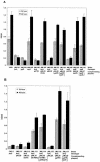The Enterococcus faecalis fsr two-component system controls biofilm development through production of gelatinase
- PMID: 15317767
- PMCID: PMC516840
- DOI: 10.1128/JB.186.17.5629-5639.2004
The Enterococcus faecalis fsr two-component system controls biofilm development through production of gelatinase
Abstract
Bacterial growth as a biofilm on solid surfaces is strongly associated with the development of human infections. Biofilms on native heart valves (infective endocarditis) is a life-threatening disease as a consequence of bacterial resistance to antimicrobials in such a state. Enterococci have emerged as a cause of endocarditis and nosocomial infections despite being normal commensals of the gastrointestinal and female genital tracts. We examined the role of two-component signal transduction systems in biofilm formation by the Enterococcus faecalis V583 clinical isolate and identified the fsr regulatory locus as the sole two-component system affecting this unique mode of bacterial growth. Insertion mutations in the fsr operon affected biofilm formation on two distinct abiotic surfaces. Inactivation of the fsr-controlled gene gelE encoding the zinc-metalloprotease gelatinase was found to prevent biofilm formation, suggesting that this enzyme may present a unique target for therapeutic intervention in enterococcal endocarditis.
Figures




Similar articles
-
Signal transduction, quorum-sensing, and extracellular protease activity in Enterococcus faecalis biofilm formation.J Bacteriol. 2004 Dec;186(24):8161-3. doi: 10.1128/JB.186.24.8161-8163.2004. J Bacteriol. 2004. PMID: 15576763 Free PMC article. Review. No abstract available.
-
Fsr-independent production of protease(s) may explain the lack of attenuation of an Enterococcus faecalis fsr mutant versus a gelE-sprE mutant in induction of endocarditis.Infect Immun. 2005 Aug;73(8):4888-94. doi: 10.1128/IAI.73.8.4888-4894.2005. Infect Immun. 2005. PMID: 16041002 Free PMC article.
-
IS256 abolishes gelatinase activity and biofilm formation in a mutant of the nosocomial pathogen Enterococcus faecalis V583.Can J Microbiol. 2015 Jul;61(7):517-9. doi: 10.1139/cjm-2015-0090. Epub 2015 Apr 22. Can J Microbiol. 2015. PMID: 25966618
-
Enterococcus faecalis with the gelatinase phenotype regulated by the fsr operon and with biofilm-forming capacity are common in the agricultural environment.Environ Microbiol. 2009 Jun;11(6):1540-7. doi: 10.1111/j.1462-2920.2009.01881.x. Epub 2009 Feb 16. Environ Microbiol. 2009. PMID: 19222538
-
Molecular Mechanism of Quorum-Sensing in Enterococcus faecalis: Its Role in Virulence and Therapeutic Approaches.Int J Mol Sci. 2017 May 3;18(5):960. doi: 10.3390/ijms18050960. Int J Mol Sci. 2017. PMID: 28467378 Free PMC article. Review.
Cited by
-
The incongruent gelatinase genotype and phenotype in Enterococcus faecalis are due to shutting off the ability to respond to the gelatinase biosynthesis-activating pheromone (GBAP) quorum-sensing signal.Microbiology (Reading). 2012 Feb;158(Pt 2):519-528. doi: 10.1099/mic.0.055574-0. Epub 2011 Nov 24. Microbiology (Reading). 2012. PMID: 22117005 Free PMC article.
-
Bioluminescence based biosensors for quantitative detection of enterococcal peptide-pheromone activity reveal inter-strain telesensing in vivo during polymicrobial systemic infection.Sci Rep. 2015 Feb 9;5:8339. doi: 10.1038/srep08339. Sci Rep. 2015. PMID: 25661457 Free PMC article.
-
Signal transduction, quorum-sensing, and extracellular protease activity in Enterococcus faecalis biofilm formation.J Bacteriol. 2004 Dec;186(24):8161-3. doi: 10.1128/JB.186.24.8161-8163.2004. J Bacteriol. 2004. PMID: 15576763 Free PMC article. Review. No abstract available.
-
Fsr-independent production of protease(s) may explain the lack of attenuation of an Enterococcus faecalis fsr mutant versus a gelE-sprE mutant in induction of endocarditis.Infect Immun. 2005 Aug;73(8):4888-94. doi: 10.1128/IAI.73.8.4888-4894.2005. Infect Immun. 2005. PMID: 16041002 Free PMC article.
-
Identification of Collagenolytic Bacteria in Human Samples: Screening Methods and Clinical Implications for Resolving and Preventing Anastomotic Leaks and Wound Complications.Dis Colon Rectum. 2019 Aug;62(8):972-979. doi: 10.1097/DCR.0000000000001417. Dis Colon Rectum. 2019. PMID: 31283593 Free PMC article.
References
-
- Barrett, A. J., N. D. Rawlings, and J. F. Woessner. 1998. Handbook of proteolytic enzymes, p. 350-369. Academic Press, Inc., New York, N.Y.
Publication types
MeSH terms
Substances
Grants and funding
LinkOut - more resources
Full Text Sources
Other Literature Sources

